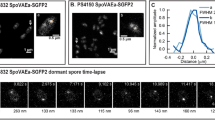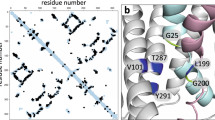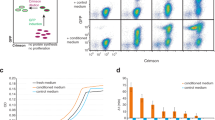Abstract
GERMINATION of fungal spores is characterized physiologically by transformation of the spore from a dormant state of low activity to a state of high metabolic activity, and morphologically at a later stage by swelling of the spore and production of a germ tube. Since activation, that is, the termination of the dormancy of the spore, is the initial stage of germination, an examination of the activation process itself makes a logical starting point to the study of the biochemical aspects of germination. This communication describes the effect of different physiological agents on the ability of spores of Penicillium roqueforti to oxidize octanoic acid and hence provides a method of assessing the influence of these agents on activation. The method may also be applicable for studies of the effects of these agents on the subsequent stages of the germination process.
This is a preview of subscription content, access via your institution
Access options
Subscribe to this journal
Receive 51 print issues and online access
$199.00 per year
only $3.90 per issue
Buy this article
- Purchase on Springer Link
- Instant access to full article PDF
Prices may be subject to local taxes which are calculated during checkout
Similar content being viewed by others
References
Yanagita, T., Arch. Mikrobiol., 26, 329 (1957).
Lawrence, R. C., Nature, 205, 1313 (1965).
Farkas, G. L., and Ledingham, G. A., Canad. J. Microbiol., 5, 141 (1959).
Cochrane, V. W., in Physiology of Fungi, 388 (John Wiley and Sons, Inc., New York, 1958).
Kornfield, J., in Spores II, edit. by Halvorson, H. O. (Burgess Publishing Company, Minneapolis, 1961).
Quastel, J. H., Canad. J. Biochem., 42, 907 (1964).
Levinson, H. S., and Hyatt, M. T., Ann. N.Y. Acad. Sci., 102, 773 (1963).
Bonner, J. T., Mycologia, 40, 728 (1948).
Gottlieb, D., Endeavour, 23, 85 (1964).
Cochrane, J. C., Cochrane, V. W., Simon, F. G., and Spaeth, J., Phytopathology, 53, 115 (1963).
Franke, W., and Heinen, W., Arch. Mikrobiol., 31, 50 (1958).
Author information
Authors and Affiliations
Rights and permissions
About this article
Cite this article
LAWRENCE, R. Activation of Spores of Penicillium roqueforti. Nature 208, 801–803 (1965). https://doi.org/10.1038/208801b0
Issue Date:
DOI: https://doi.org/10.1038/208801b0
This article is cited by
-
Vergleichende Untersuchungen zur Biogenese fl�chtiger Produkte des Sekund�rstoffwechsels
Archiv f�r Mikrobiologie (1968)
Comments
By submitting a comment you agree to abide by our Terms and Community Guidelines. If you find something abusive or that does not comply with our terms or guidelines please flag it as inappropriate.



